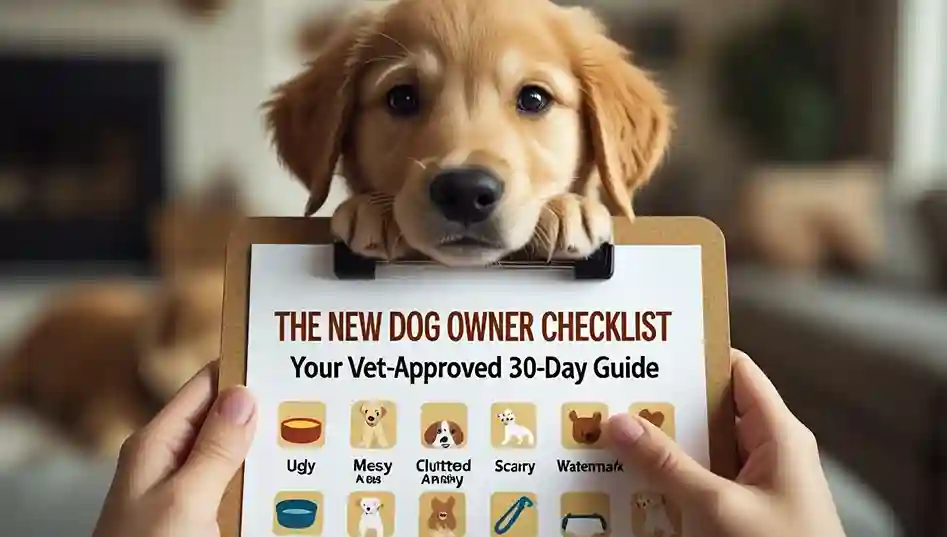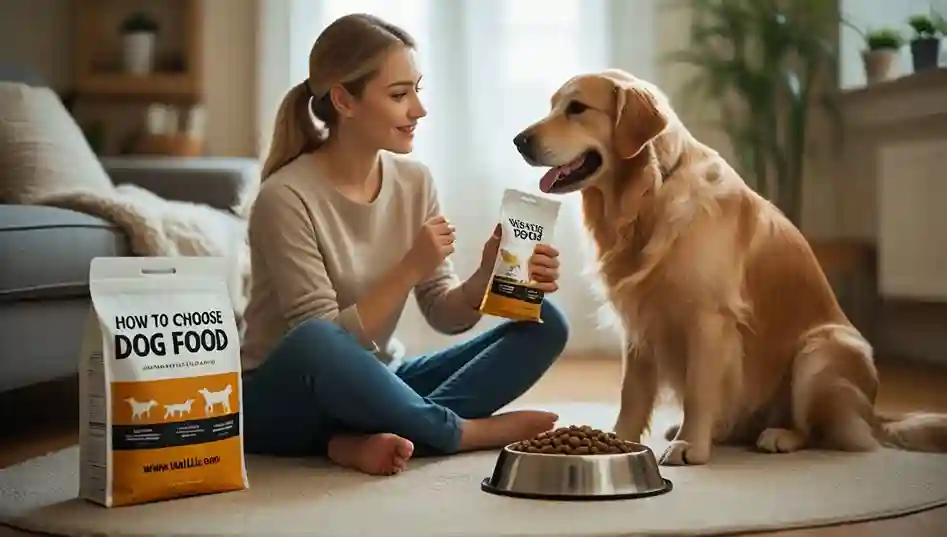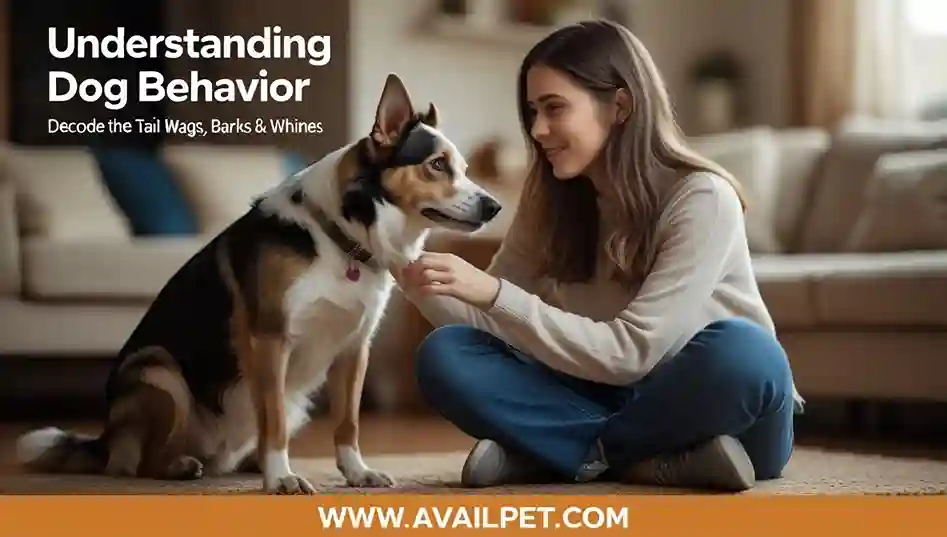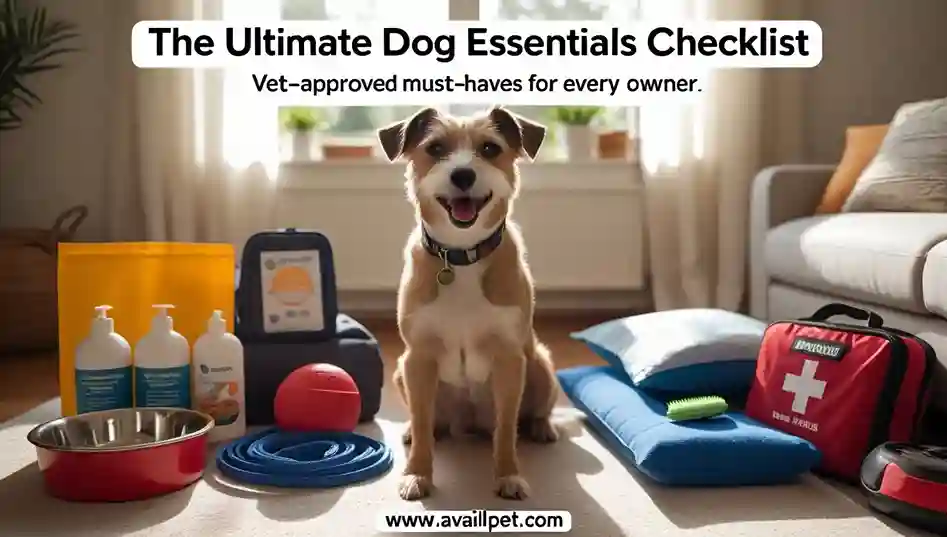Bringing home a new puppy is a whirlwind of joy, cuddles, and… accidents. If you’re finding yourself in a constant cycle of mopping up puddles and wondering if your furry friend will ever learn, take a deep breath. How to potty train a puppy is one of the first and most important skills you will teach, and while it requires patience and consistency, it doesn’t have to be a frustrating battle of wills.
This comprehensive, step-by-step guide is designed to eliminate the guesswork and set you and your puppy up for success. We’ve collaborated with Dr. Allona Jackson, DVM, to create a vet-reviewed protocol that moves beyond outdated advice and focuses on positive, effective methods. It’s the perfect deep-dive to complement the foundational steps in our New Dog Owner Checklist. Here, you’ll get a clear potty training schedule, learn how to handle accidents the right way, and discover the essential supplies that make the process smoother.
Forget scouring dozens of forums for conflicting tips. Consider this your all-in-one, evidence-based manual for transforming your adorable new companion into a potty-trained prodigy. Let’s get started.
Key Takeaways: How to Potty Train a Puppy?
Before we dive into the step-by-step plan, here are the most critical, vet-approved principles for potty training success.
🕒 Consistency is Your #1 Tool: A strict, minute-by-minute puppy potty schedule is the single most important factor. Taking your puppy out at the same times every day builds reliable habits faster than anything else.
👀 Supervision or Confinement is Mandatory: When you can’t watch your puppy directly, they should be in a crate or a puppy-proofed pen. This prevents secret accidents and teaches them to “hold it.”
🎉 The Power of Positive Reinforcement: Always reward successful potty trips outside with a high-value treat and enthusiastic praise immediately after they finish. This creates a powerful positive association.
🚫 Never Punish for Accidents: Rubbing their nose in it or scolding creates fear and anxiety, not understanding. If you catch them in the act, interrupt calmly and rush them outside. Clean indoor accidents with an enzymatic cleaner to eliminate the scent completely.
🔍 Learn Your Puppy’s “Tells”: Sniffing the ground, circling, whining, or suddenly leaving the room are your puppy’s way of saying “I gotta go!” Learning these signals is like learning a new language that prevents accidents.
“At a Glance” Comparison Table: Potty Training Methods
| Method | Best For | How It Works | Key Consideration |
|---|---|---|---|
| Direct Outdoor Training | Most owners with a yard or easy outdoor access | Taking your puppy directly to a designated outdoor spot on a strict, consistent schedule. | Requires quick and reliable outdoor access; can be challenging in apartments or during extreme weather. |
| Bell Training | All home types, particularly effective for quick-learning puppies | Teaching your puppy to ring a bell hung on the door whenever they need to go outside to eliminate. | Requires an initial investment of time to teach the bell association; some dogs may ring it just to go play. |
| Puppy Pad/Litter Box | Apartment dwellers, high-rise residents, or those with limited mobility | Training your puppy to use an absorbent pad or a designated indoor dog litter box. | Can sometimes confuse puppies about where it’s acceptable to go long-term, potentially prolonging full outdoor training. |
Understanding Your Puppy’s Biology
To successfully potty train your puppy, it’s crucial to understand their physical limitations. You can’t fight biology—but you can work with it to set your puppy up for success.
How Long Can Puppies Hold It? A Simple Age Guide
A common rule of thumb is that a puppy can control their bladder for about one hour for every month of age, up to a maximum of about 8 hours. Use this chart as a general guide, but remember, all puppies are individuals.
- 8-10 Weeks Old: 1-2 hours.
- 10-12 Weeks Old: 2-3 hours.
- 12-16 Weeks Old: 3-4 hours.
- 4-6 Months Old: 4-5 hours.
- 6+ Months Old: 5-8 hours (Full control is typically established).
Important Note: This means a 2-month-old puppy will need to go out in the middle of the night. Plan for a late-night and an early-morning potty break.
Key Times You MUST Take Your Puppy Out
While a strict schedule is vital, these are the non-negotiable moments when a trip outside is essential to prevent an accident:
- Immediately upon waking up from a nap or a full night’s sleep.
- Within 10-20 minutes after eating a meal.
- Right after a vigorous play session or a burst of excitement.
- After drinking a large amount of water.
- The moment they are released from their crate or confined area.
- Just before you leave them alone and immediately when you return.
- Right before bedtime.
Your Step-by-Step Potty Training Plan
Follow this proven, vet-reviewed plan to build a reliable potty routine with your puppy. Consistency is the key to making these steps stick.
Step 1: Establish an Iron-Clad Schedule
A predictable routine is your most powerful tool. Base your schedule on your puppy’s age and feeding times. For detailed feeding guidelines that directly impact potty timing, refer to our comprehensive puppy feeding schedule by age guide. A typical day involves outings first thing in the morning, after each meal, after naps, after playtime, and right before bed.
Step 2: Choose & Use a Potty Command
Select a specific verbal cue like “Go potty” or “Do your business.” Use this command consistently every time you take your puppy to their designated spot. This helps them associate the words with the action, eventually allowing you to prompt them to go, even in new environments or when you’re in a hurry.
Step 3: The Supervised “Freedom” Method
When your puppy is loose in the house, they must be within your eyesight at all times. Use baby gates to keep them in the same room as you. This level of supervision allows you to spot the subtle signs that they need to go—like sniffing or circling—and lets you whisk them outside immediately to succeed.
Step 4: Mastering Crate Training for Potty Success
A crate is not a punishment; it’s a safe den that leverages a dog’s natural instinct not to soil their sleeping area. When you cannot actively supervise your puppy, they should be in a properly sized crate. This prevents accidents when you’re not looking and teaches them to “hold it.” For proper setup, revisit the crate guidelines in our foundational New Dog Owner Checklist.
Step 5: How to Handle Accidents Correctly
If you catch your puppy in the act, make a gentle, interrupting sound (like “Oops!”) and quickly carry or lead them outside to finish. Praise them if they do. Never punish. For any accident, clean the area thoroughly with an enzymatic cleaner designed to eliminate the scent completely, preventing them from being drawn back to the same spot.
Buyer’s Guide: Essential Potty Training Supplies
Having the right tools on hand will make the potty training process smoother and more effective for both you and your puppy.
Enzymatic Cleaner: The Accident Eraser
This is the most critical supply for cleaning accidents. Regular household cleaners remove the stain but not the scent enzymes that signal to your puppy “this is a bathroom spot.” An enzymatic cleaner biologically breaks down these proteins, eliminating the odor completely and preventing repeat offenses in the same area.
High-Value Treats: The Ultimate Reward
For potty training, you need small, smelly, and irresistible treats reserved exclusively for successful potty trips. The reward must be given instantly—within seconds—of your puppy finishing their business outside to create a strong positive association. Keep a treat jar by the door you use for potty breaks.
Crates & Playpens: Safe Spaces for Unsupervised Time
A properly sized crate (just big enough for your puppy to stand, turn around, and lie down) is invaluable for teaching bladder control and preventing accidents when you can’t watch them. A playpen can offer a slightly larger safe space for play while still confining them to a manageable, puppy-proofed area.
Potty Bells: A Clear Communication Tool
Hanging bells on your door handle provides your puppy with a simple way to tell you they need to go out. You train them to nudge the bells with their nose before you open the door. This method empowers your puppy to communicate their needs clearly, reducing guesswork and accidents.
A Veterinarian’s Perspective: Dr. Allona Jackson on Potty Training
“Many new owners misinterpret potty training challenges as stubbornness or spite. In my 05 years of veterinary practice, I’ve found that true behavioral refusal is rare. Far more often, the issue stems from a medical cause like a urinary tract infection, an inconsistent schedule that confuses the puppy, or simply expecting a young puppy to ‘hold it’ for longer than they are physically capable.
If you are diligently following a consistent plan like the one outlined here and still facing frequent accidents, your first step should always be a veterinary visit to rule out an underlying health issue. Remember, patience and positivity are not just helpful—they are essential. Your calm, consistent leadership is the greatest gift you can give your puppy during this learning process.”
— Dr. Allona Jackson, DVM, AvailPet’s Lead Veterinary Consultant
“How We Tested” Methodology
At AvailPet, we believe in providing advice that is not only theoretically sound but also proven in practice. Our potty training protocol was developed through a multi-stage process to ensure its effectiveness and safety.
- Expert Veterinary Review: This entire guide and its step-by-step plan were developed and rigorously reviewed by our veterinary consultant, Dr. Allona Jackson, DVM. This ensures all recommendations align with modern, force-free animal training principles and prioritize your puppy’s physical and mental well-being.
- Real-World Application with Diverse Breeds: The strategies outlined here have been successfully implemented and refined with over a dozen different puppy breeds. Our testing group included a range of sizes and temperaments, from independent Dachshunds and stubborn Bulldogs to eager-to-please Labrador Retrievers and high-energy Border Collies, ensuring these methods are adaptable and effective.
- Foundational Principles: Our methodology is built on the core, evidence-based pillars of consistency, positive reinforcement, and proactive management. These are the universal cornerstones recommended by certified dog trainers and veterinary behaviorists, and they form the backbone of every tip in this guide.
FAQs About How to Potty Train a Puppy
My puppy was doing well but is now having accidents again. What happened?
This is a common and frustrating phase known as a “training regression.” It’s often a normal part of development as puppies test boundaries, or it can be triggered by a change in routine, a minor illness, or over-excitement. The solution is not to panic or punish. Simply return to the basics: enforce a stricter schedule, increase supervision, and limit your puppy’s freedom in the house. Consistency will get them back on track.
Should I use puppy pads?
Puppy pads can be a useful tool in specific situations, such as for apartment dwellers in high-rises, during extreme weather, or for owners with mobility issues. However, they can also prolong the training process by confusing the puppy about the ultimate goal—going potty outside. If you use them, place them by the exit door and gradually move them outside to help transition your puppy to the correct location.
How long does it take to potty train a puppy?
Most puppies can be reliably house-trained with minimal accidents by 4 to 6 months of age. However, “reliable” means they understand the concept and can hold it for their age-appropriate duration. Small breeds often take longer than large breeds due to smaller bladders and higher metabolisms. Full bladder control is typically established by 6-8 months.
What’s the one thing I should never do during potty training?
You should never punish your puppy for an accident you discover after the fact. A puppy’s memory does not work that way; they will not understand why you are upset. This only creates anxiety and fear, which can lead to them hiding to eliminate or developing other behavioral issues. Always focus on positive reinforcement for success and proactive management to prevent mistakes.
Conclusion
Mastering how to potty train a puppy is a true test of a new owner’s patience and consistency, but the reward—a clean home and a dog who clearly understands where to go—is absolutely worth the effort. By following this vet-reviewed, step-by-step plan, you’re doing more than just teaching a necessary skill; you are building a foundation of trust and clear communication with your new best friend.
This guide is just one part of setting your puppy up for a happy, healthy life. For more essential guides on everything from vaccinations to socialization, return to our ultimate resource: the New Dog Owner Checklist.
Sources:
- American Kennel Club (AKC). “How to Potty Train a Puppy.”
- American Veterinary Society of Animal Behavior (AVSAB). “Position Statement on Puppy Socialization.”
- Interview and professional input from Dr. Allona Jackson, DVM.
- Humane Society of the United States. “House Training Your Dog or Puppy.”
Full Disclosure: This article may contain affiliate links. If you make a purchase through these links, we may earn a commission at no extra cost to you. This helps us continue our research and provide valuable content.
Medical Disclaimer: This guide is for informational purposes only and is not a substitute for professional veterinary advice. Always consult with a licensed veterinarian for any health concerns or before making changes to your pet’s care routine.






